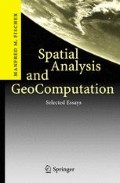Abstract
The chapter outlines the general architecture of a knowledge based GISystem that has the potential to intelligently support decision making in a GIS environment. The efficient and effective integration of spatial data, spatial analytic procedures and models, procedural and declarative knowledge is through fuzzy logic, expert systems and neural network technologies. A specific focus of the discussion is on the expert system and neural network components of the system, technologies which had been relatively unknown in the GIS community at the time this chapter was written.
Access this chapter
Tax calculation will be finalised at checkout
Purchases are for personal use only
Preview
Unable to display preview. Download preview PDF.
References
Baldi P. and Hornik K. (1989): Neural networks and principal component analysis: Learning from examples without locall minima, Neural Networks 2, pp. 53–58.
Carpenter G.A. and Grossberg S. (1987): ART 2: Self-organisation of stable category recognition codes for analog input patterns, Applied Optics 26(3), pp. 4919–4930
Clarke M. (1990): Geographical information systems and model based analysis: Towards effective decision support systems. In: Scholten H.J. and Stillwell J.C.M. (eds.) Geographical Information Systems for Urban and Regional Planning, Kluwer Academic Publishers, Dordrecht, Boston, London, pp. 165–175
Fischer M.M. and Gopal S. (1992): Neural networks models and interregional telephon traffic: Comparative performance comparisons between multiplayer feedforward networks and the conventional spatial interaction model, Paper presented at the Symposium of the IGU-Commission on Mathematical Modelling, Princeton, August 5–7, 1992 (=WSG-DP 27, Department of Economic and Social Geography, Vienna University of Economics and Business Administration)
Fischer M.M. and Nijkamp P. (eds.) (1992): Geographic Information Systems, Spatial Modelling, and Policy Evaluation, Springer, Berlin, Heidelberg, New York
Goodchild M.F. (1991): Progress on the GIS research agenda. In: Harts J., Ottens H.F.L. and Scholten H.J. (eds.) EGIS’ 91. Proceedings, Second European Conference on Geographical Information Systems, Volume 1, Utrecht: EGIS Foundation, pp. 342–350
Graham I. (1989): Inside the inference engine. In: Forsyth R. (ed.) Expert Systems, Principles and Case Studies, Chapman and Hall, London, pp. 57–83
Hall C. (1992): Neural net technology: Ready for prime time? IEEE Expert 7(6), 2–4
Halmari P.M. and Lundberg C.G. (1991): Bridging inter-and intra-corporate information flows with neural networks, Paper presented at the Annual Meeting of the Association of American Geographers, Miami, April 13–17, 1991
Hecht-Nielsen R. (1990): Neurocomputing, Addison-Wesley, Reading [MA]
Hopfield J.J. (1984): Neurons with graded response have collective computational properties like those of two-state neurons, Proceedings of the National Academy of Sciences 81 (Biophysics), 3088–3092
Kawaguchi A., Motoda H. and Mizoguchi R. (1991): Interview-based knowledge acquisition using dynamic analysis, IEEE Expert 8(5), 47–60.
Kim T.J., Wiggins L.L. and Wright J.R. (eds.) (1990): Expert Systems: Applications to Urban and Regional Planning, Kluwer Academic Publishers, Dordrecht, Boston, London, pp. 191–201
Kobayashi S. and Nakamura K. (1991): Knowledge compilation and refinement for fault diagnosis, IEEE Expert 8(5), 39–46
Kohonen T. (1984): Self-Organisation and Associative Memory, Springer, Berlin, Heidelberg, New York
Leung Y. (1992): Towards the development of an intelligent decision support system. In: Fischer M.M. and Nijkamp P. (eds.) Geographical Information Systems, Spatial Modelling, and Policy Evaluation, Springer, Berlin, Heidelberg, New York, pp. 131–145
Mc’Lord Nelson M. and Illingworth W.T. (1990): A Practical Guide to Neural Nets, Addison-Wesley, Reading [MA]
Openshaw S. (1992a): Modelling spatial interaction using a neural net. In: Fischer M.M. and Nijkamp P. (eds.) Geographical Information Systems, Spatial Modelling, and Policy Evaluation, Springer, Berlin, Heidelberg, New York, pp. 147–164
Openshaw S. (1992b): Some suggestions concerning the development of artificial intelligence tools for spatial modelling and analysis in GIS. In: Fischer M.M. and Nijkamp P. (eds.) Geographical Information Systems, Spatial Modelling, and Policy Evaluation, Springer, Berlin, Heidelberg, New York, pp. 17–33
Openshaw S. (1990): A spatial analysis research strategy for the Regional Research Laboratory Initiative, Regional Research Laboratory Initiative Discussion Paper No. 3
Openshaw S., Cross A. and Charlton M. (1990): Building a prototype Geographical Correlates Exploration Machine, International Journal of Geographical Information Systems 4, 297–311
Openshaw S., Wymer C. and Charlton M. (1991): An evaluation of three neural net classifiers on census data for Britain, Paper presented at the 7th European Colloquium on Quantitative and Theoretical Geography, Hasseludden (Sweden), September 5–8, 1991
Rumelhart D.E., Hinton G.E. and Williams R.J. (1986): Learning representations by backpropagating errors, Nature 323, 533–536
Smith T.R., Peuquet D., Menon S. and Agarwal P. (1987): KBGIS-II. A knowledge based geographical information system, International Journal of Geographic Information Systems 1, 149–172
Wang F., Hall G.B. and Subaryono (1990): Fuzzy information representation and processing in conventional GIS software: Database design and application, International Journal of Geographical Information Systems 4, 261–283
Webster C. (1990): Rule-based spatial search, International Journal of Geographical Information Systems 4, 241–259
White R.W. (1989): The artificial intelligence of urban dynamics: Neural net modelling of urban structure, Papers of the Regional Science Association 67, 43–53
Wilson G.V. and Pawley G.S. (1988): On the stability of the traveling-salesman problem algorithm of Hopfield and Tank, Biological Cybernetics 58, 63–70
Rights and permissions
Copyright information
© 2006 Springer Berlin · Heidelberg
About this chapter
Cite this chapter
(2006). Expert Systems and Artificial Neural Networks for Spatial Analysis and Modelling. In: Spatial Analysis and GeoComputation. Springer, Berlin, Heidelberg . https://doi.org/10.1007/3-540-35730-0_5
Download citation
DOI: https://doi.org/10.1007/3-540-35730-0_5
Publisher Name: Springer, Berlin, Heidelberg
Print ISBN: 978-3-540-35729-2
Online ISBN: 978-3-540-35730-8
eBook Packages: Business and EconomicsEconomics and Finance (R0)

